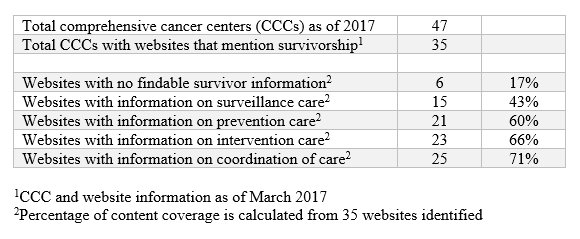This blog post covers work I supported by first author Betsy Rolland, of the University of Wisconsin-Madison, in assessing the findability of survivor information on Comprehensive Cancer Center websites. This paper has been published in the July 2018 issue of the Journal of the National Comprehensive Cancer Center Network. If you are a survivor or advocate without journal access, please email Dr. Rolland for a pre-print copy.
The transition from cancer treatment to cancer survivorship doesn’t come with a lot of good, detailed instructions. It’s particularly difficult to transition from the rigid schedules of treatment (chemotherapy, radiation, blood work) to the structural void of survivorship, which can come with challenges from late effects of treatment, such as PTSD, cognitive deficits, or financial troubles.

Dr Rolland and I undertook this project with the goal of figuring out what it’s like to be a cancer survivor and having to navigate information available from comprehensive cancer centers about survivorship care. We applied a method called content analysis to systematically evaluate the information available to a survivor or their caregiver about survivorship (e.g., availability of relevant services, finding survivorship specialists, and understanding the timing of recommended regular checkups post-cancer). Dr Rolland brought me on as a specialist in content analysis, as well as a cancer survivor.
First, we looked around the Comprehensive Cancer Center (CCC) websites a bit. We asked: What kinds of information would we need to successfully care for a cancer survivor? And, How much of this information is findable on the CCC sites? As we investigated the sites, we discussed our observations. When we discussed the information available on the CCC sites, we were often (1) unable to find the information we expected about survivorship care, and (2) unable to discern how survivorship information was organized on individual sites.
How to proceed? That led to the second step.
Next, we sought out guidance about how survivors should engage with medical and self care post-remission (or cure, or no evidence of disease, or NED). We found a great guide at the American College of Surgeons about patient-centered survivorship care. We also looked into the Institute of Medicine’s (IOM) Survivorship Care Plan guidelines, which included its essential components: Surveillance care, Prevention care, Intervention care, and Coordination of care. With this guidance, we could assess the content of the CCC sites, and see how they measured up!
The third step was using the structure provided by the IOM guidelines and mapping it onto the findable content from the CCC sites. In other words, if we use the four components listed above as a set of “standards” for survivorship care, then we were able to measure the findability of content related to those standards for each CCC site. That’s how we assessed, or “scored,” the findability of recommended survivorship information for each CCC site (Figure 1).
Figure 1: Brief highlights of findings
Our results: a lot of the CCC sites are pretty good, at minimum, in presenting info that would bring survivors to the clinic for care. Based on these findings, we make recommendations for improving site content related to survivorship. When CCCs enhance their online survivor information content, this can also help not just survivors in its immediate area, but also serve as a well of content for regional/smaller cancer centers, or even nonprofit organizations, from which survivors may also seek information. In conclusion, our recommendations are just one part of bridging gaps in cancer survivor information and care needs, which will continue to improve long-term outcomes in cancer care.
Photo by Carlton Browne and used per CC 2.0 license.